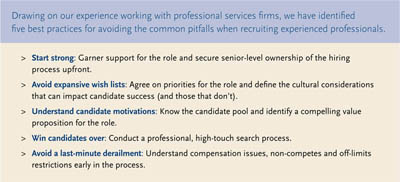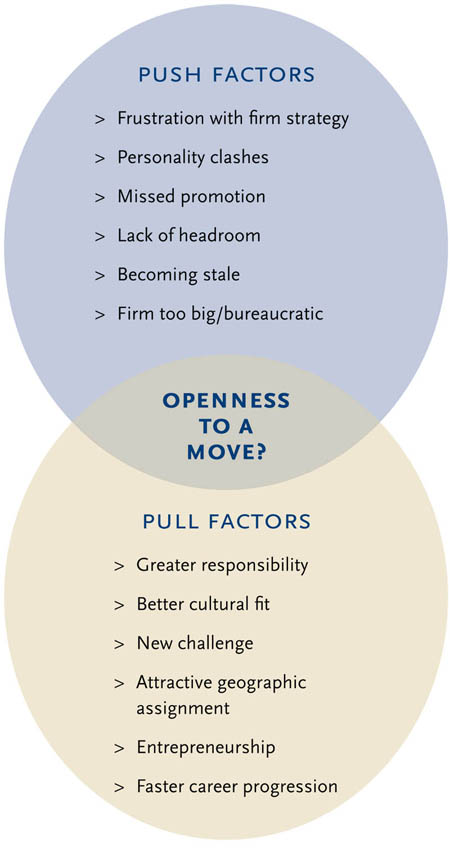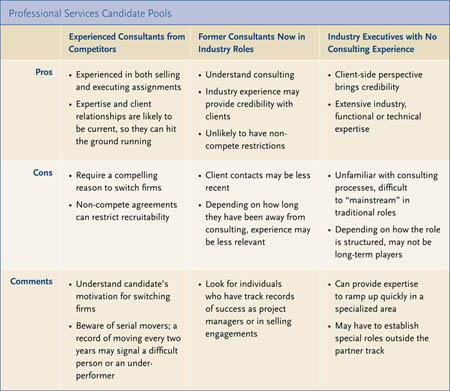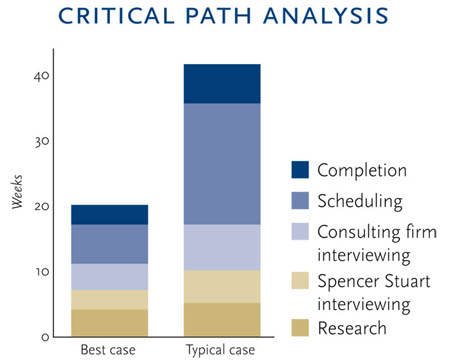Recruiting experienced professionals has become a more important talent management tool for professional services firms in recent years. Extremely rare a decade ago, firms now regularly recruit consultants from competitors or executives from industry to ramp up a new practice quickly or address a practice leadership gap that cannot be filled internally. The growing sophistication of clients is driving an evolution in the client service model, from one in which generalists worked across industries to one demanding that firms develop specialists providing cutting-edge, functional depth in a wide range of areas.
Finding individuals with the specialized expertise, cultural compatibility, commercial skills and the intellectual heft to excel in a professional service environment is challenging. The process can take many months longer to complete than a traditional executive search and can require many more prospects and candidates to find the right fit. Furthermore, many professional services firms lack the infrastructure and processes for recruiting senior-level people because of their long-term focus on campus recruiting and internal talent development. Strong candidates can slip through the cracks because of a flawed search process or the failure to “sell” experienced professionals on the opportunity.

View larger image
1. Start Strong
Garner support for the role and secure senior-level ownership of the hiring process upfront.
It may seem obvious, but getting broad buy-in for the need for a new hire and the specific requirements for the role from all the critical stakeholders is essential to a successful search, particularly in professional services firms where most significant decisions are made by consensus. A search can stall or derail when key partners do not agree about the role requirements or are lukewarm about the need for the position. Set the stage for a smoother hiring process by identifying the “jury” of decision-makers who will have a say in the hire and involve them early in the process. By investing time upfront in identifying the partners who are critical to the decision, firms can avoid situations in which a candidate is rejected after a lengthy process by someone further up or across the organization.
Searches also can lose focus and momentum without a senior partner to champion the process or when the senior partner in charge of the search delegates its management to human resources. Recruiting an experienced hire can take many months, often requiring candidates to meet 10 to 20 partners before an offer is made. In a world where partners travel extensively and clients come first, it can be hard to keep a search on track. A well-respected senior partner will have the clout to drive the process forward — involve the right people, ask for partners’ time, schedule time to debrief about candidates and ensure that feedback is shared with the search firm and candidate.
Best-practice firms have a senior recruiting coordinator who manages the search, nudges partners to make time on short notice to meet candidates, gathers feedback and communicates with the candidates. One approach we have seen used successfully is assigning an active or “semi-retired” senior partner as the recruiting coordinator. This individual should care deeply about the cause and be willing to devote time, and sometimes expend his or her own political capital, to move the process along with fellow partners. This partner can also serve as a “peer counselor” to the candidate, giving him or her an experienced connection who can help work through the complications that can arise during recruitment and the first year of onboarding.
2. Avoid Expansive Wish Lists
Agree on priorities for the role and define the cultural considerations that can impact candidate success (and those that don't).
Carefully consider which skills are critical to being effective in the role. Certain capabilities will be more or less important depending on the specific position and the maturity of the practice, including: business development, practice building and leadership, intellectual capital, people development, delivery and execution. Also, be realistic about whether your goal with the new hire is to add capability or to bring on new clients. The latter does not always materialize as clients are often more connected with the firm than the individual.
As in any search, cultural fit is a key consideration when evaluating candidates, particularly for experienced professionals whose careers have been shaped in other environments. Conduct an honest assessment of the most important dimensions of the firm’s culture and what they mean for the candidate profile. Is a team-oriented person or a solo artist most likely to succeed? Does the compensation system reward collaboration or encourage people to “eat what they kill”? Does decision-making come from the top down or is it more consensual? On the other hand, firms that place too much emphasis on cultural fit can lose sight of other important considerations, such as a candidate’s commercial viability and track record. If a candidate brings the right expertise and strong commercial skills, the firm may be able to ease his or her transition through the onboarding process.
Finally, don’t let unrealistic expectations eliminate candidates. “One big mistake professional services firms make is to apply the same ‘pass rate’ to experienced candidates as they do to campus hires,” one senior partner told us. “The year we first started, we couldn’t even get a candidate to second rounds because the mindset was only one in four was going to be decent enough to pass. In fact, we turned down a lot of good candidates because our partners had no idea how to evaluate them.”
3. Understand Candidate Motivations
Know the candidate pool and identify a compelling value proposition for the role.
Professional services firms are accomplished recruiters on university campuses, thanks to the power of their brands and the developmental opportunity such roles provide for bright, ambitious graduates. But these are less compelling draws to experienced professionals, who need to have a good reason to leave their current position. The most attractive senior candidates are well-established where they are and have more at risk when changing jobs. For candidates at competitors, leaving their current firm does not just represent a job change, it also requires them to break away from a partner community, potentially placing personal friendships at risk.
Experienced candidates, therefore, must be relentlessly pursued and given a real value proposition for why they should make a move. In general, a mix of “push” and “pull” factors influence a person’s willingness to leave their current job. Although they have little control over factors such as individuals’ frustration with their company’s strategy or perceptions about opportunities in their current job, firms should have a compelling proposition to address relevant pull factors. For some, this may mean an accelerated track to partner election, the opportunity to manage a global practice or an assignment in the candidate’s preferred location.
Experienced candidates tend to emerge from three primary sources: consultants at competitor firms; former consultants who are now in industry roles; and industry executives with no consulting experience.

View larger image
Competitors can be hard to attract because they tend to be loyal to their current firm and may have non-compete restrictions. It also is important to understand the candidate’s motivation for making a switch. “Beware the person who just got a smaller-than-expected bonus,” advised a senior partner at one firm. “He or she might ‘act out’ and interview with another firm but decide in the end that the grass is not actually greener. The people who will make the leap will have a longer-term reason, not just a knee-jerk moment of disgruntlement with their current firm. The partner bond runs deep. These are the people you have grown up with professionally. These are the people you have worked until 3 a.m. with, the people you have competed for business with, and the people you have celebrated with when you won. This doesn’t dissolve overnight, and there had better be some serious pull from the partners at the hiring firm if they expect to break these bonds.”
Former consultants now in industry roles can be attractive candidates because they understand consulting, have client-side experience and may bring contacts from their current role. Furthermore, the bond with their former firm is broken and they are unlikely to have non-compete restrictions. The best candidates in this category are those who had meaningful track records of success as project managers at their prior firms.
Industry executives without consulting experience can be successful “rainmakers” or provide specialized technical knowledge to help a firm launch a new practice area. Many firms are creating special advisory or “expert” roles that take advantage of the expertise of these individuals, rather than place them in traditional partner path roles, where they may struggle because of a lack of selling and delivery experience. See the Professional Services Candidate Pools chart [below] for more detail about the different types of candidates.

View larger image
4. Win Candidates Over
Conduct a professional, high-touch search process.
It may be surprising to learn that professional services firms, which are so skilled at client service, can fall short in their treatment of candidates. Given the clientfacing nature of their roles and travel demands on them, partners in professional services can struggle to make time for interviews or follow-up discussions about candidates.
All candidates expect professionalism and courtesy from potential employers, and they can be easily alienated or lose interest in the opportunity if interviews are frequently canceled and rescheduled or if weeks go by without contact. One approach that can help keep a search on track is to identify the partners who are essential for making the hiring decision, and prioritize those people when scheduling interviews. Another useful approach is conducting a streamlined and highly coordinated interview process. For example, one firm creates a high-touch impression in candidates by arranging initial interviews in the candidate’s city. If the initial meetings go well, a day of second round interviews is scheduled at the firm’s regional headquarters. If those discussions are successful, the candidate is flown to other regions to complete the interview process.

View larger image
Another common complaint from candidates is an interview process that requires them to respond to the same set of questions from multiple interviewers. When a candidate meets a dozen or so partners asking nearly identical questions, it comes across as uncoordinated, inefficient, tedious and unprofessional. A better approach is to work out in advance who will be involved in the interview process and what each interviewer will set out to accomplish. View each interview as an opportunity to focus on a different facet of the candidate: sector knowledge, cultural fit, business development style and people development, for example.
5. Avoid a Last-Minute Derailment
Understand compensation issues, non-competes and off-limits restrictions early in the process.
Don’t allow the search to derail late in the process because of a lack of due diligence on key issues such as compensation, non-competes and off-limits restrictions.
Few things can be as frustrating as finding the right candidate and having negotiations break down at the last minute because of challenges related to compensation or non-competes and off-limits. When recruiting from the competition, most partners have some form of non-compete agreement in place, which must be identified early on so contingency plans can be developed. And, in fact, several firms have found themselves embroiled in court battles over non-compete issues, while other firms have rescinded offers to candidates to avoid conflicts with competitors.
Some professional services firms also have restrictive off-limits agreements, which not only prevent recruiting from current clients, but also restrict recruiting from past clients, marginal clients or potential clients.
Finally, understand the limits on compensation. Some common compensation challenges include valuing shares in unlisted firms and determining the value of the candidate’s retirement plan.
The stakes are high for professional services firms increasing their recruitment of experienced consultants. As these additions have the potential to change the consultant mix and alter firms’ very fabric, firms are recognizing that they need to have an effective recruiting process that does not allow strong candidates to slip through the cracks and, more importantly, finds and recruits the right people.
Professional services firms can improve their ability to recruit individuals with the specialized expertise, cultural compatibility and commercial skills to succeed if they follow a process that:
- Secures support for the role and senior-level ownership of the hiring process at the outset
- Hones in on the priorities for the role
- Defines a compelling value proposition for potential candidates
- Wins candidates over through a high-touch search process
- Avoids last-minute surprises that can derail the successful completion of the search
Finally, firms should not underestimate the importance of onboarding. Failing to successfully transition an experienced professional can negatively affect a firm’s ability to recruit in the future; news about failed hires will spread, making it harder to attract others.
In many respects, the elements that are important in recruiting experienced hires are also important in helping them transition: a clear charter and a senior sponsor who is well-respected in the firm can help the new person understand how to navigate the firm and bring the firm’s resources to bear on behalf of the client.